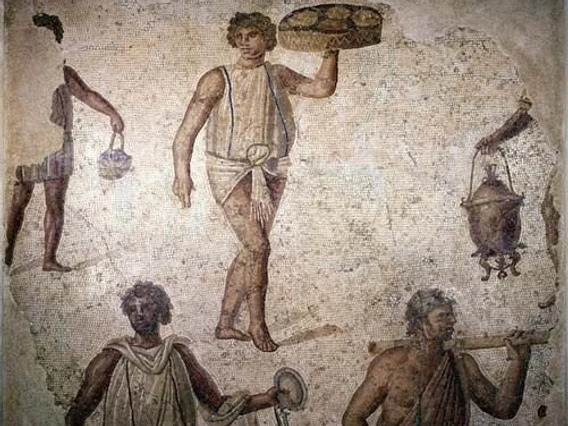
Urine collection pot from the shop of a fuller (launderer) in Pompeii, Italy
The first two books of my new historical fiction trilogy, A Slave’s Story, follow the experience of an aging aristocrat in Roman Asia Minor who is suffering from a mysterious intestinal ailment that involves frequent trips to the toilet. This story line compelled me to dig into a topic that is frequently overlooked by authors of historical fiction: how did people in the past attend to their bodily needs?
As was customary around the world until fairly modern times, many people simply relieved themselves on the streets or in the fields. In Rome itself (and probably in other cities as well), clay pots were set up in public places to collect urine (yes, they did it right there!) for use in laundering clothes and tanning leather. This sounds strange to us, but urine contains ammonia which is useful for cleaning. The Romans even used it as a mouthwash! Even stranger (by our standards) is the use of human urine and feces as a component in making certain medicines. Human feces were also added to garden soil as a form of fertilizer. Clearly they did not know about germ theory!

Public latrine from Ostia, Italy
Cities also had public latrines where people could relieve themselves in a somewhat more secluded setting, but there was nothing like the privacy that we expect from a public toilet. A latrine was basically an open room with outhouse-style seats lined up around the perimeter with no barriers between the seats, like the one shown above. People probably conversed as they did their business. When they were done, they dipped a sponge on a stick into a small trough of water that ran in front of the benches to clean themselves. Women and men seem to have used the same facilities–at least there is no evidence for gender-segregated toilets. (More images are available at https://u.nu/dyp56.)

Roman chamber pot found at Pompeii, Italy
When at home, most people would have used chamber pots like the one pictured above, which they then emptied out into the street. Given that many people lived in multi-story apartment buildings, one had to be careful when walking under their windows! When people were sick, as in my novels, the contents of their chamber pots were examined closely by physicians as a vital part of their diagnostic routine. Sometimes they even tasted it as part of their examination!

Indoor toilet from Pompeii, Italy
Elite Roman homes had indoor toilets, though most consisted of little more than a seat above a drain-pipe or chamber pot tucked away in a small closet, like the one shown above. A bucket of water and a sponge were situated nearby for clean-up duties. (More images from various archaeological sites can be viewed at https://u.nu/k63je.) The wealthy also kept chamber pots in their bedrooms for use at night. Of course, it was the duty of slaves to empty these pots and to periodically clean the pipes in the toilets.
Since one of my main characters (Lucius) has an illness that brings him into frequent contact with toilets, these images will enable my readers to envision the various facilities that appear in the books (or not, as you wish!). Some readers will no doubt be put off by this aspect of my stories, but the descriptions are both medically accurate and vital to the narrative. I consulted with a colorectal surgeon regarding what a person with (spoiler alert!) untreated colon cancer would experience, and that’s what I described. It’s certainly not pretty, but I didn’t set out to write a novel that would be made into a movie!



